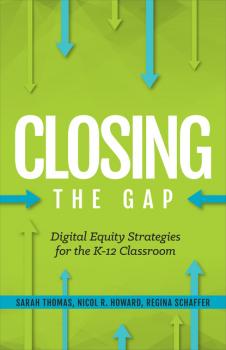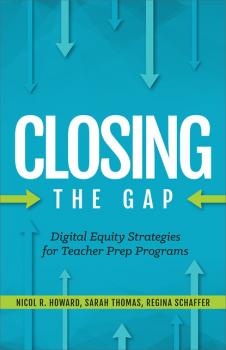Учебная литература
Различные книги в жанре Учебная литератураClosing the Gap
Closing the Gap is an ISTE book series designed to reflect the contributions of multiple stakeholders seeking to ensure that digital equity is achieved on campuses, in classrooms, and throughout education. In this series, authors Nicol R. Howard, Sarah Thomas, and Regina Schaffer offer historical and philosophical insights while exploring challenges and solutions unique to teacher preparation programs, pre-service and in-service teachers, and instructional coaches.
The second book in the series, Closing the Gap: Digital Equity Strategies for the K-12 Classroom, includes: examination of digital equity and the “problem of practice” for teachers and coaches; strategies for connecting the ISTE Educator and Student Standards to practice; discussion of key challenges facing teachers in today’s classrooms, such as access, connectivity, limited resources, digital divide, and the homework gap; research-based vignettes from teachers who have encountered and conquered some of the challenges addressed in the book, and from edtech coaches who have implemented equity-centered innovative professional development; and concrete, evidence-based strategies for teachers.
Engaging Young Readers
Educators need to be able to engage with readers at every level, and part of their role is to evaluate where each student lies on the continuum and to improve their skills to bring them to the appropriate level. This book is a beginner-level guide focusing on developmental reading strategies for elementary students at all stages, exploring how technology can be used to improve the skills of a wide range of readers, including beginning readers, struggling readers, reluctant readers, enriched readers, and English Language Learners (ELLs). This book will give teachers the strategies and technology they need to meet their students where they are in their personalized skill development and to move forward.
Integrating Technology in the Classroom
Teachers possess unique skills, knowledge and experience. So why should their approaches to classroom technology look the same? In this new edition of the popular book Integrating Technology in the Classroom, author Boni Hamilton helps you discover technology tools and projects that resonate with your teaching style, classroom context and technology skill level all while helping students achieve academic growth. In this book, you’ll discover new and immediately applicable tools and practices to support collaborative, student-centered learning.
In this new edition, you’ll find: coverage of programming, game creation, and augmented and virtual reality; stories of teachers who have successfully employed technology in the classroom, with more examples from secondary-level teachers, including visual learning preferences and kinesthetic/tactile learning; deeper explanation of how to leverage technology to meet multilingual needs; a new chapter on leveraging technology to meet adaptive needs, including examples from teachers who use adaptive technologies in regular classrooms; strategies that address efficiency needs of teachers, to help make administrative tasks less onerous, and coverage of learning management systems, formative assessment sites, and planning tools; and professional development coverage that includes information on ISTE offerings, social media, and other supports.
Closing the Gap
Closing the Gap is an ISTE book series designed to reflect the contributions of multiple stakeholders seeking to ensure that digital equity is achieved on campuses, in classrooms, and throughout education. In this series, authors Nicol R. Howard, Sarah Thomas, and Regina Schaffer offer historical and philosophical insights while exploring challenges and solutions unique to teacher preparation programs, pre-service and in-service teachers, and instructional coaches.
The first book in the series, Closing the Gap: Digital Equity Strategies for Teacher Prep Programs, includes: a discussion of historical placement of “digital equity” content in teacher education programs; research- and evidence-based vignettes from teacher educators, higher education deans, and department coordinators demonstrating best practices; examples of ISTE Standards in action; practical tips for preparing future teachers to navigate the process; positive applications of digital equity; and a hypothesis for the future direction of digital equity in teacher education.
This book will inform teacher education programs and future research, providing positive examples and recommendations for educational technology leaders and educators on moving toward digital equity in K12 and teacher education.
Reinventing Project Based Learning
This popular ISTE title follows the arc of a project, providing guided opportunities to direct and reflect educators’ own learning and professional development. In this updated, tenth-anniversary edition, Suzie Boss and Jane Krauss offer educators new examples of the latest tools, assessment strategies and promising practices that are poised to shape education in the future. Reinventing Project-Based Learning, Third Edition shows how to design authentic projects that make the most of available and emerging technologies.
This new edition: provides examples of how to merge personalized learning, flipped classrooms, and PBL for effective teaching and learning; includes coverage of computational thinking and coding, demonstrating ways to develop new approaches to solving problems as well as new forms of expression; discusses PBL as an equity consideration, with opportunities for personalization and empowerment, addressing issues of social justice and closing the achievement gap; includes coverage on new trends like augmented and virtual reality, and new and updated Spotlights from educators; and features deeper focus on Gold Standard and High Quality PBL, the P21 Framework, and ISTE Standards for Students and Educators.
Education Reimagined
Educational leaders play a central role in developing a culture of change and providing the conditions for innovation in schools, and that role varies by job title. District leaders make changes across multiple schools, principals lead change across their schools and teacher leaders guide change within and across grade levels. But no matter the role, a framework that identifies the knowledge and behaviors required for leaders to make student learning possible and for teachers to be empowered is a necessity. The ISTE Standards for Education Leaders offer a concrete framework to help leaders set goals and provide a vision for transformative systems change within educational institutions. The ISTE Standards for Educators and the ISTE Standards for Students are also used by leaders to provide holistic change with a shared vision and direction for all. Education Reimagined provides aspiring and established leaders an on-ramp for using the ISTE Standards to guide change in their educational systems. This booklet contains examples showing how those in specific leadership roles can use the ISTE Standards in their work; reflection questions applicable to all leadership roles; vignettes demonstrating how a variety of leaders in a diverse range of schools have embraced the ISTE Standards for Education Leaders; an explanation of other frameworks and standards that connect with and complement the ISTE Standards for Education Leaders and a crosswalk between the ISTE Essential Conditions and the ISTE Standards for Education Leaders.
Teaching AI
For many, artificial intelligence, or AI, may seem like a new, and possibly overwhelming concept. The reality is that AI is already being applied in industry and, for many of us, in our daily lives as well. A better understanding of AI can help you make informed decisions now, that will impact the future of your learners. This book explores what AI is, how it works and how educators can use it to better prepare students in a world with increased human-computer interaction.
This book features perspectives from educators and industry experts on how they are using AI; approaches to teaching about AI including design thinking, project based learning and STEM connections; tools for exploring AI and sharing it with your students; and activities to introduce AI concepts, reflection questions and lesson ideas.
Leading from the Library
The modern school library supports education in a variety of ways. One essential role librarians play is that of a leader who works collaboratively to build relationships, mold culture and climate, and advocate for the needs of students and the community.
In this book, a librarian and an education leader team up to reflect on the librarian’s ability to build connections in two ways. First, they discuss the benefits of bringing the outside world into the library through the use of social media, videoconferencing and other tools that allow librarians to partner with others. Then they expand upon these connections by addressing how librarians can lead in the greater educational community by sharing resources and strategies, and partnering with school leaders to tell the story of the school community.
Through this book, librarians will discover the influence they can have on the school community as the library becomes the heart of the school, a place where problems are solved, content is explored, connections are made and discovery happens.
Edtech for the K-12 Classroom
Technology in the K-12 classroom is no longer an option. To prepare students for the future of work, life and citizenship, every school needs to be equipped with digital tools and staffed by educators who can harness technology to accelerate innovation in teaching and learning. Edtech for the K-12 Classroom is designed to empower future teachers to use technology effectively in their classrooms and schools. Meant to supplement or replace edtech textbooks, this ebook is a compilation of articles and multimedia offering concrete lesson plans, inspiring reflections and advice from edtech experts on how to empower learners using technology. The book includes readings, supplemented by videos, webinars and infographics, tied to the widely adopted ISTE Standards with examples on how to align lessons to the ISTE Standards for Students to empowers learners to be effective communicators, computational thinkers, innovative designers, global collaborators and digital citizens.
We Are Generation Z
Born at the turn of the millennium, the members of Generation Z are no strangers to today's fast-paced, hyperconnected world. They were born in the Digital Age. They grew up online. Their identities, attitudes, and perspectives have all been uniquely integrated with technology. Now, as they stand at the brink of adulthood, it's time for the world to discover: Who is Generation Z? Vivek Pandit shares an insider's perspective on what it means to be part of this unique generation. By exploring the forces that have shaped him and his peers, he gives insight into how they may go on to shape the world. <i>We Are Generation Z</i> was awarded the 2015 Moonbeam Children's Book Award Gold Medal in the Youth Author (under 18) category.









